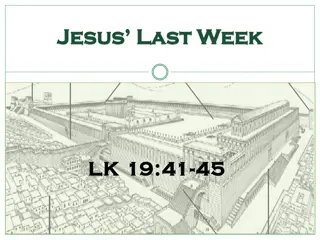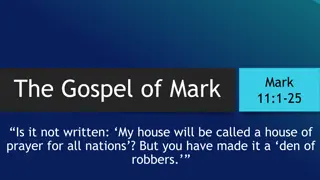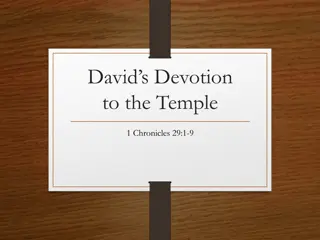Insights on Herod's Temple and Jesus' Teachings from Mark 13
Explore the profound teachings of Jesus from Mark 13 in relation to Herod's Temple. Discover the significance of the widow's offering, the warnings about false Christs, the signs of the temple's destruction, and the call to stand firm in faith despite challenges.
Download Presentation

Please find below an Image/Link to download the presentation.
The content on the website is provided AS IS for your information and personal use only. It may not be sold, licensed, or shared on other websites without obtaining consent from the author.If you encounter any issues during the download, it is possible that the publisher has removed the file from their server.
You are allowed to download the files provided on this website for personal or commercial use, subject to the condition that they are used lawfully. All files are the property of their respective owners.
The content on the website is provided AS IS for your information and personal use only. It may not be sold, licensed, or shared on other websites without obtaining consent from the author.
E N D
Presentation Transcript
Then they will see the Son of Man coming in the clouds with great power and glory. And then He will send His angels, and gather His elect from the four winds, from the farthest part of earth to the farthest part of heaven (Mark 13:26, 27, NKJV)
The elders who had seen Solomon's temple wept when they saw the small, humble temple built by Zerubbabel (Ezra 3:8-13). Herod the Great wanted to reconcile with the Jews by reforming that humble temple. He made it the architectural marvel that the disciples praised before Jesus. But Jesus saw beyond those luxurious stones; that magnificent gold; and that visual wonder. He saw Roman armies destroying everything in their path. He saw the place built for the glory of God devastated by the wickedness of God's people. By showing that reality, he mixed it with the vision of blessed hope: one day Jesus will come to put an end to evil and sin.
A SPARK OF HOPE Herod's temple had several atriums. In the so-called women's atrium there were 13 chests where offerings were deposited. Each of them was intended for a specific objective (e.g. buying firewood). Jesus was watching how large and small sums were deposited into those chests, when he was impressed by a widow's small offering (Mark 12:41-42). Unlike the rich bidders, this widow did not want to be praised. She only wanted to contribute to God's work with the little she had (Mark 12:43-44). She did not care about the corruption prevailing among the priests. Her offering was for God, not for men. Jesus was soon going to announce the destruction of the temple because of Israel's corruption and wickedness. But in the midst of the prevailing evil, this widow represented the sincere worshipers who still recognized the sanctity of the Temple as the House where God desired to be worshiped.
Everyone will hate you because of me, but the one who stands firm to the end will be saved (Mark 13:13) Climbing the Mount of Olives, a disciple drew Jesus' attention to Herod's magnificent temple (Mark 13:1). His response left everyone stunned (Mark 13:2). When asked by the fishermen brothers (Mark 13:3-4), Jesus divided his response into these three phases: In the first phase, Jesus indicated that false Christs would soon arise (and continue to arise) presenting a falsified gospel (Mark 13:5-6). These will generate turbulence, but it is not the end yet (Mark 13:7-8). The importance of preaching the gospel and its consequences (v. 5-13) The signs of the destruction of the temple (v. 14-23) Before the destruction of the Temple, the gospel was preached throughout the known world. And until Jesus comes, we must be prepared to present our faith clearly, regardless of the consequences (Mark 13:9-13; 1Pet. 3:15). The signs of the end of the world (v. 24-37)
THE DESTRUCTIVE HAND When you see the abomination that causes desolation standing where it does not belong let the reader understand then let those who are in Judea flee to the mountains (Mark 13:14) Jesus linked the destruction of the Temple with the prophecies of Daniel (Dn . 9:27; 11:31; 12:11). The 70- week prophecy presents a prince [Rome] who would destroy the city and the temple after the death of the Messiah. This is the desolator who filled Jerusalem with abominations (Dn. 9:26-27). Luke makes it clear that the abomination of desolation refers to Jerusalem surrounded by Roman armies (Lk. 21:20). This occurred in 66 AC when Cestius Gallus attempted to take Jerusalem. Their unexpected retreat allowed the Christians to abandon the city and save their lives (Mark 13:15-18). A year later, Nero sent Vespasian to quell the rebellion, and he left Titus to continue the siege, until the total destruction of the city in the year 70.
After explaining the destruction of the Temple, Jesus begins to talk about what would happen between that event and His Second Coming: a time of extreme tribulation (Mark 13:19). This tribulation is against the elect , that is, those who remain faithful to Jesus (Mark 13:20). The tribulation period involves the persecution of the faithful people by the religious power that dominated the Middle Ages. During that period, many paid with their lives for their desire to read the Bible, and to be loyal to its teachings. Daniel 7:25 and other passages tell us that the persecution would last 1,260 years (between 538 and 1798). Before 1798, after the Reformation, persecution subsided in some parts of Europe. Many had to flee their countries to take refuge in Germany or Switzerland, in order to escape persecution.
We may know that if our life is hid with Christ in God, when we are brought into trial because of our faith, Jesus will be with us. When we are brought before rulers and dignitaries to answer for our faith, the Spirit of the Lord will illuminate our understanding, and we shall be able to bear a testimony to the glory of God. And if we are called to suffer for Christ's sake, we shall be able to go to prison trusting in Him as a little child trusts in its parents. Now is the time to cultivate faith in God. EGW (Our High Calling, December 17)
As the end of the tribulation approached, the signs announced by Jesus began to be fulfilled (Mark 13:24-25): Afterwards, Jesus will appear in a visible, powerful and glorious way; the dead in Christ will rise again; and the living faithful will be transformed (Mk. 13:26-27; 1Thes. 4:16-17). When will this great event happen? Jesus tells us that when we see the signs, we will know that it is coming (Mark 13:28-29). In conclusion, Jesus assured that the events concerning the destruction of the Temple would be contemplated by that same generation (Mark 13:30-31). But, regarding his Second Coming, he warns us that no one knows the moment. Our part is to watch (Mark 13:32-37).
The exact time of Christ's second coming is not revealed. Jesus said, No man knoweth the day nor the hour. But He also gave signs of His coming, and said, When ye shall see all these things, know that it is near, even at the doors Matthew 24:48, 36, 33. [ ] Since we know not the hour of Christ's coming, we must live soberly and godly in this present world, Looking for that blessed hope, and the glorious appearing of the great God and our Saviour Jesus Christ. EGW (Reflect Jesus, September 1)























